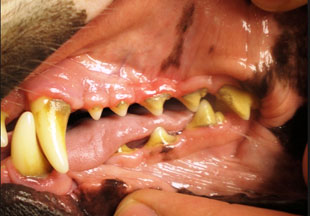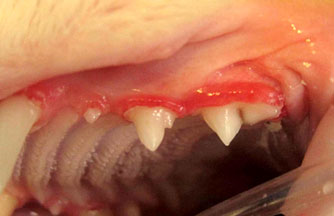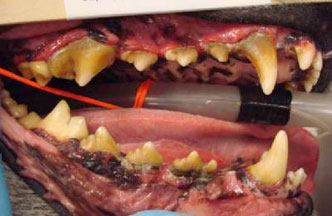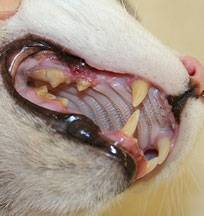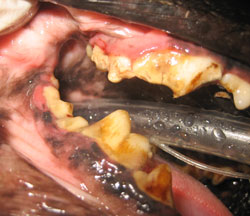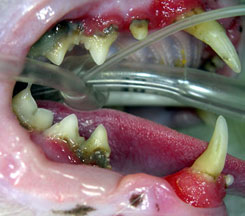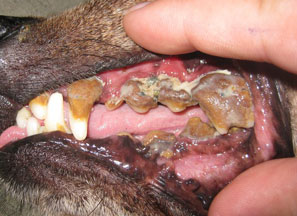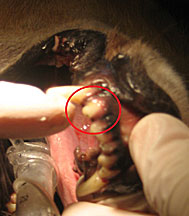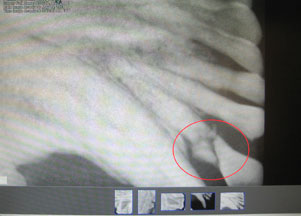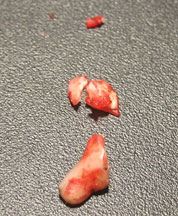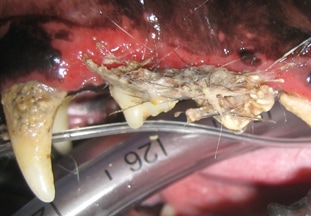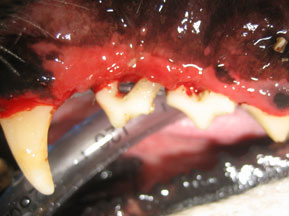Dental disease is the most common disease in dogs and cats. It is estimated that over 68% of dogs and cats over the age of three have some sign of dental disease. Most pets are very good at hiding the signs of dental disease so it is up to you and your veterinarian to uncover this hidden and often painful condition.
The oral health of your pet has a profound impact on the animal’s general health. Research data has shown a clear link between dental disease and many common health problems. Bacteria and toxins caused by periodontal disease may enter the blood stream causing systemic diseases affecting the heart, liver, lungs and kidneys.
Symptoms of Dental Disease
Some of the symptoms that your pet may be having problems include showing a decreased interest in food or they may approach the food bowl and then show a reluctance to eat which may result in weight loss. Bad breath and blood tinged saliva or drool may also be noted. If the pet is in extreme pain they may vocalize their discomfort, paw at their mouth or shake their head frequently.
Stages of Dental Disease
Stage 1: Mild Gingivitis
The first stage of dental disease is a mild redness to the gingiva, or gums. In the early phases of gingivitis, some plaque is present and there is a mild redness of the gums, but the gingival surfaces are smooth. Fortunately, gingivitis is almost always preventable or reversible by regular tooth-brushing at home and occasional dental cleanings by your veterinarian.
The oral health of your pet has a profound impact on the animal’s general health. Research data has shown a clear link between dental disease and many common health problems. Bacteria and toxins caused by periodontal disease may enter the blood stream causing systemic diseases affecting the heart, liver, lungs and kidneys.
Symptoms of Dental Disease
Some of the symptoms that your pet may be having problems include showing a decreased interest in food or they may approach the food bowl and then show a reluctance to eat which may result in weight loss. Bad breath and blood tinged saliva or drool may also be noted. If the pet is in extreme pain they may vocalize their discomfort, paw at their mouth or shake their head frequently.
Stages of Dental Disease
Stage 1: Mild Gingivitis
The first stage of dental disease is a mild redness to the gingiva, or gums. In the early phases of gingivitis, some plaque is present and there is a mild redness of the gums, but the gingival surfaces are smooth. Fortunately, gingivitis is almost always preventable or reversible by regular tooth-brushing at home and occasional dental cleanings by your veterinarian.
Stage 2: Moderate Gingivitis
This stage is identified by red, inflamed gums and a strong odor from the mouth. Your pet will experience pain and may not want to eat. Your veterinarian will recommend a dental cleaning at this time and home care to prevent further development of gingivitis.
This stage is identified by red, inflamed gums and a strong odor from the mouth. Your pet will experience pain and may not want to eat. Your veterinarian will recommend a dental cleaning at this time and home care to prevent further development of gingivitis.
Stage 3: Severe Gingivitis
At this stage, you will notice red, bleeding gums and your pet will be experiencing pain from infection and heavy tartar. The tartar has pushed the gums away from the teeth, causing pockets that provide a perfect platform for more bacterial overgrowth. This stage has a low possibility of being reversed and your veterinarian may need to remove some of the teeth due to bone loss and gingival recession.
At this stage, you will notice red, bleeding gums and your pet will be experiencing pain from infection and heavy tartar. The tartar has pushed the gums away from the teeth, causing pockets that provide a perfect platform for more bacterial overgrowth. This stage has a low possibility of being reversed and your veterinarian may need to remove some of the teeth due to bone loss and gingival recession.
Stage 4: Periodontal Disease
Untreated gingivitis progresses to periodontitis and can lead to life-threatening spread of bacteria throughout your pet’s bloodstream. Periodontal disease is the inflammation and infection of the tissues surrounding a tooth. Build up of tartar causes gum recession around the tooth. As the infection spreads, it causes the gums to recede, exposing sensitive tooth surfaces. This is extremely painful for the pet and should receive medical attention immediately.
Untreated gingivitis progresses to periodontitis and can lead to life-threatening spread of bacteria throughout your pet’s bloodstream. Periodontal disease is the inflammation and infection of the tissues surrounding a tooth. Build up of tartar causes gum recession around the tooth. As the infection spreads, it causes the gums to recede, exposing sensitive tooth surfaces. This is extremely painful for the pet and should receive medical attention immediately.
Dental Cleaning Information
If your veterinarian has recommended a dental cleaning for your pet, rest assured that we provide the highest quality care before, during and after the procedure. Before putting your pet under anesthesia, we will perform a pre-anesthesia lab analysis. Not all conditions are readily detected by a general physical examination. Since dental disease can lead to kidney, liver, lung and heart disease, it is important to objectively evaluate your pet’s internal organs. Lab work will allow us to check the pet’s kidney and liver functions, blood count, scan for infections and electrolyte levels to ensure the pet is healthy enough to proceed.
After the doctor has performed a pre-anesthetic physical exam and reviewed the pre-anesthetic lab analysis, the pet is put under general anesthesia. The heart and respiratory system will be monitored using safe and modern anesthetic protocols including electrocardiograph and pulse oximeter machines. Most pets wake up minutes after the procedures are completed and we provide warmth during and after anesthesia to prevent your pet from cooling and to keep them as comfortable as possible.
An ultrasonic scaler removes the tartar above and below the gum line, but also breaks down the cell wall of the bacteria, killing it. This is the same ultrasonic scaling procedure used on humans. The doctor will use a dental probe around each tooth to determine if there are any periodontal pockets and the normal free space between gingiva and tooth is measured and documented in the pet’s medical history.
It is not uncommon to find fractured teeth or abscesses of the roots that may be causing your pet pain. Dental radiographs are used to check under the gum line to get to the “root of the problem”. Extracting teeth is a surgical procedure which your doctor will discuss with you should problems be found.
In this example, the Licensed Veterinary Technician noticed a loose tooth while performing a dental scaling. The doctor ordered an Xray and found that the tooth was broken below the gumline. This was a source of pain for the dog so the tooth was extracted and put on several days of pain meds. We are happy to report that he is back to his normal self and there is no more dental pain.
If your veterinarian has recommended a dental cleaning for your pet, rest assured that we provide the highest quality care before, during and after the procedure. Before putting your pet under anesthesia, we will perform a pre-anesthesia lab analysis. Not all conditions are readily detected by a general physical examination. Since dental disease can lead to kidney, liver, lung and heart disease, it is important to objectively evaluate your pet’s internal organs. Lab work will allow us to check the pet’s kidney and liver functions, blood count, scan for infections and electrolyte levels to ensure the pet is healthy enough to proceed.
After the doctor has performed a pre-anesthetic physical exam and reviewed the pre-anesthetic lab analysis, the pet is put under general anesthesia. The heart and respiratory system will be monitored using safe and modern anesthetic protocols including electrocardiograph and pulse oximeter machines. Most pets wake up minutes after the procedures are completed and we provide warmth during and after anesthesia to prevent your pet from cooling and to keep them as comfortable as possible.
An ultrasonic scaler removes the tartar above and below the gum line, but also breaks down the cell wall of the bacteria, killing it. This is the same ultrasonic scaling procedure used on humans. The doctor will use a dental probe around each tooth to determine if there are any periodontal pockets and the normal free space between gingiva and tooth is measured and documented in the pet’s medical history.
It is not uncommon to find fractured teeth or abscesses of the roots that may be causing your pet pain. Dental radiographs are used to check under the gum line to get to the “root of the problem”. Extracting teeth is a surgical procedure which your doctor will discuss with you should problems be found.
In this example, the Licensed Veterinary Technician noticed a loose tooth while performing a dental scaling. The doctor ordered an Xray and found that the tooth was broken below the gumline. This was a source of pain for the dog so the tooth was extracted and put on several days of pain meds. We are happy to report that he is back to his normal self and there is no more dental pain.
The last step of the dental cleaning is polishing the teeth with a fluoride paste. Polishing is important because the ultrasonic scaler leaves microscopic grooves in the enamel and if a polish is not used, bacteria will readily attach to these grooves and start to form plaque. Additional pain medications and/or antibiotics may be administered if deemed appropriate.
Additional Pet Dental Information
Furcation:
This dog was presented with excessive tartar buildup. Because the dog had a skin condition as well, he licked his feet a lot which caused hair to become stuck in the cement-like tartar. After the tartar is removed we find that the patient suffers from a stage 3 furcation which means that a dental probe can pass completely through the space between the roots. This was caused by the tartar which pushed the gums so far up that the roots are exposed. The dog had lost 5lbs due to dental pain so the tooth was extracted.
Additional Pet Dental Information
Furcation:
This dog was presented with excessive tartar buildup. Because the dog had a skin condition as well, he licked his feet a lot which caused hair to become stuck in the cement-like tartar. After the tartar is removed we find that the patient suffers from a stage 3 furcation which means that a dental probe can pass completely through the space between the roots. This was caused by the tartar which pushed the gums so far up that the roots are exposed. The dog had lost 5lbs due to dental pain so the tooth was extracted.
Site powered by Weebly. Managed by IDEXX Laboratories

